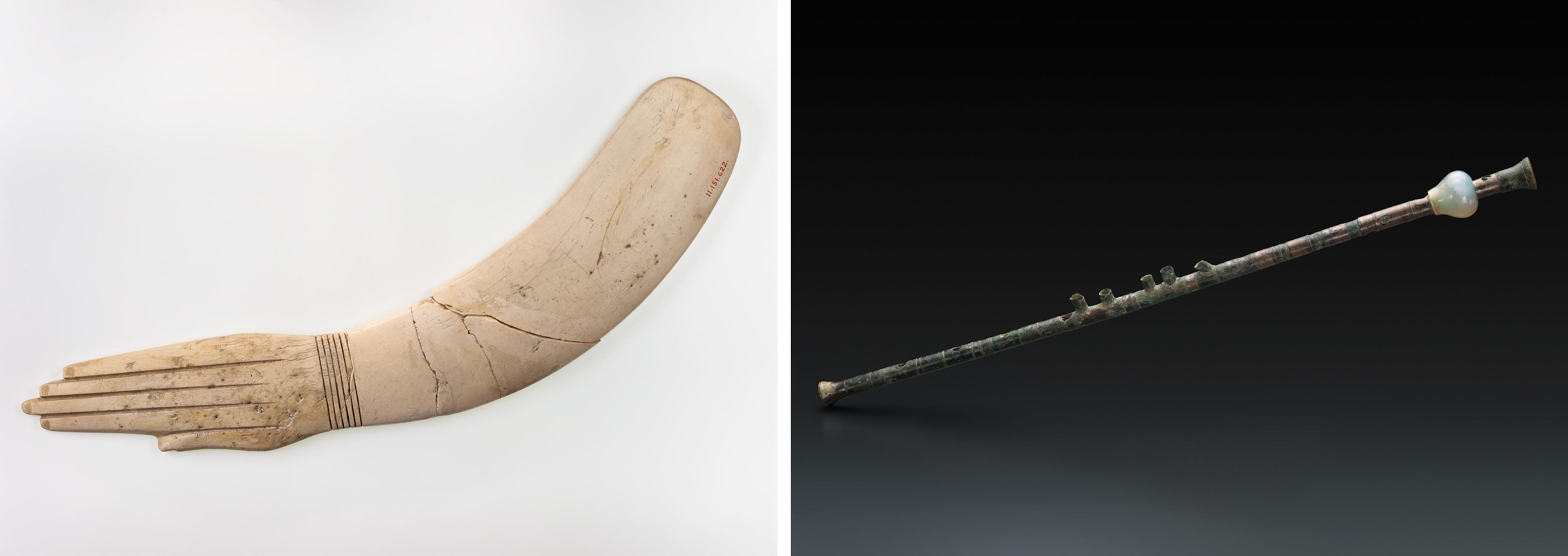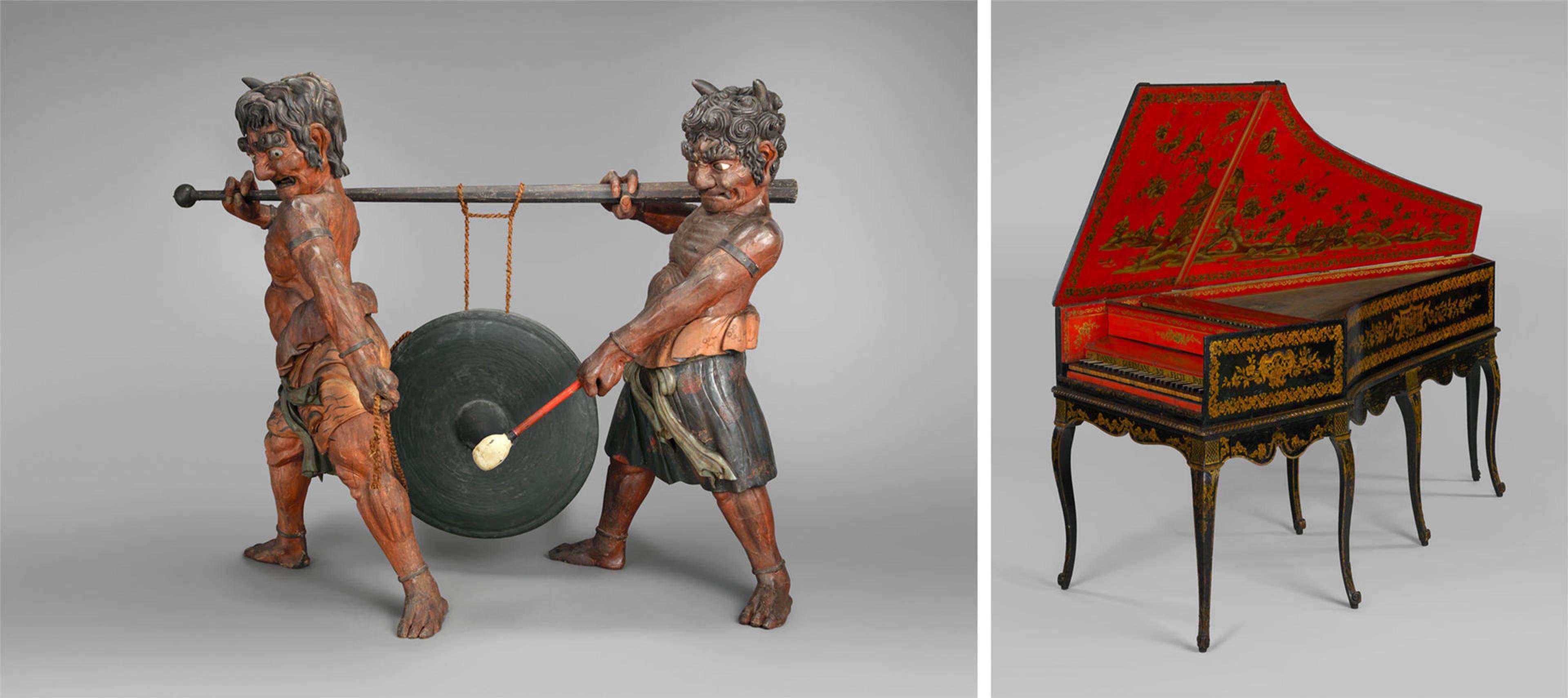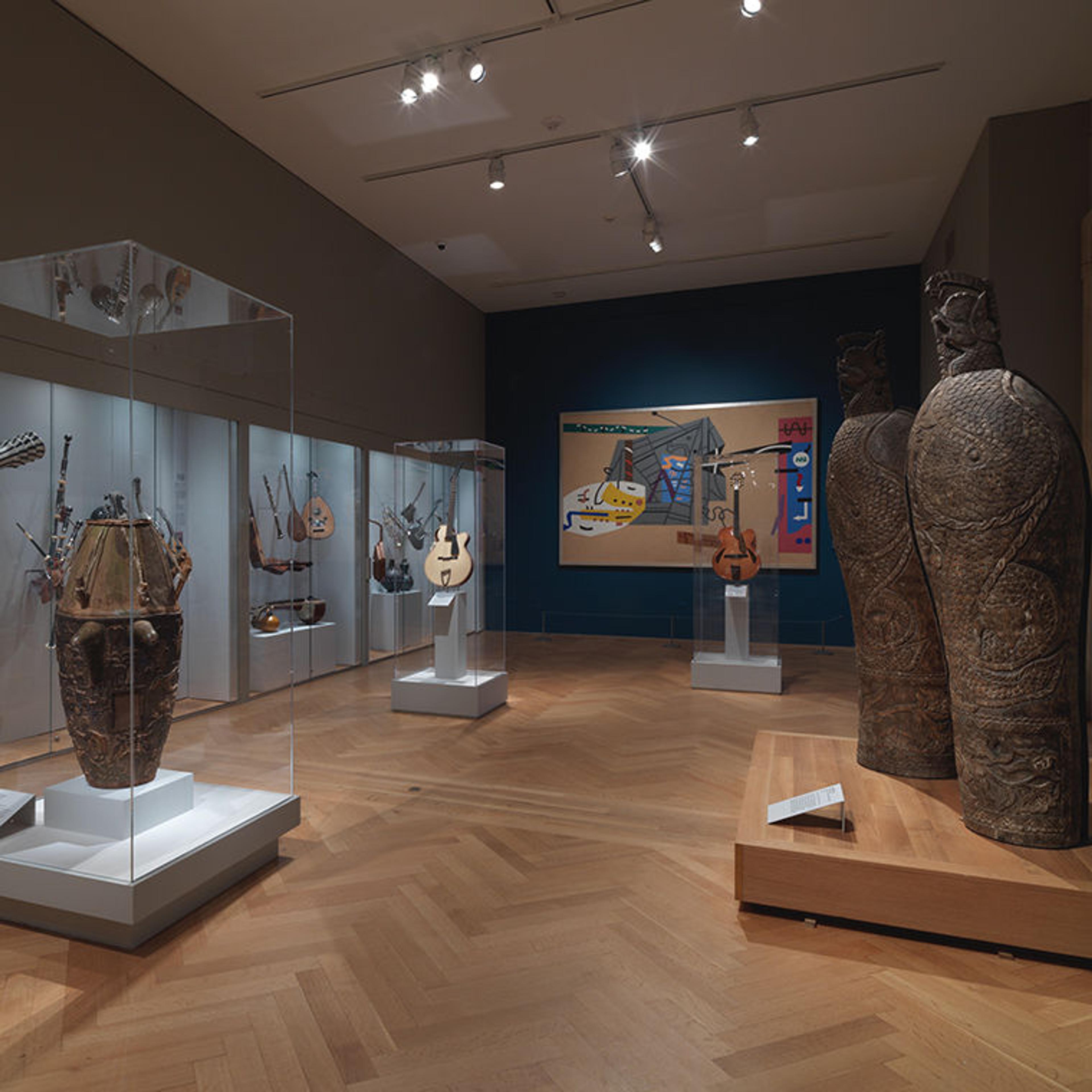
The Met's Art of Music through Time presentation in gallery 684
Opened this spring after an extensive renovation, the Art of Music through Time gallery at The Met is a departure for the Department of Musical Instruments. For the first time, key selections from the Museum's diverse collection of instruments are presented together chronologically, without regard to geographic origin. Among the curious and illuminating juxtapositions are a late sixteenth-century Chinese pipa alongside the Museum's famed "Kurtz" violin, designed by Andrea Amati around 1559.
Relationships like these stress the global narrative of music and instruments—a key goal for curators Jayson Dobney and Bradley Strauchen-Scherer, who oversaw the installation. I recently spoke with them about their objectives, some of their favorite objects, and what makes The Met a special place to present musical instruments within a broader context.
Pac Pobric: Let's begin at the beginning. What's the main idea behind the Art of Music through Time gallery?
Bradley Strauchen-Scherer: It's important to think of this holistically. For us, it really represents a departure. Even though the physical upgrades and improvements in the gallery are important and wonderful, I think it was most exciting for us as curators because we got to think about this as a tabula rasa. Why are musical instruments at The Met? Who is our audience? What does it mean that all seventeen curatorial departments in the Museum have things in their collections that represent music? We got really excited about trying to connect some of these dots and couch things within a broader context.
Jayson Dobney: Musical instruments are common to peoples all over the world and throughout time—and they are unique, because of all the kinds of art that can be seen here at The Met, they are the only art objects that also make art. That's the story we are telling here. So we are showing pieces from the ancient world to the present across cultures.
The oldest pieces in this gallery—this is a question we get a lot from people—are these fantastic ivory clappers from ancient Egypt. They are made from hippopotamus ivory and they're shaped like human hands. That's quite wonderful because when we talk about music, we think the first sounds humans made were with the body. They were clapping, stomping, whistling, singing—all of those body parts needed to make sound are the first instruments. Here we have a physical reminder of that. We have objects on loan here from ten different curatorial departments, including Egyptian, Ancient Near Eastern, Greek and Roman, and Asian.

Left: Clapper. Middle Kingdom, Dynasty 12, late–13, (ca. 1850–1750 B.C.). From Egypt, Memphite Region, Lisht North, cemetery west of the tomb of Senwosret, MMA excavations, 1906–07. Ivory, L. 8 7/16 in. (21.4 cm); W. 1 7/16 in. (3.7 cm); Th. 5/16 in. (0.8 cm). The Metropolitan Museum of Art, New York, Rogers Fund, 1911 (11.151.622). Right: Tibia, ca. 1–500. Syrian. Ivory, silver, chalcedony, H. 23 1/16 in. (58.6 cm); D. (at end) 1 in. (2.5 cm). The Metropolitan Museum of Art, New York, Rogers Fund, 1958 (58.40)
Bradley Strauchen-Scherer: One fantastic instrument from the ancient world is this Roman tibia, which is an ancestor of our oboe. It looks sort of archaeological and abstract, but when you walk through The Met and you see things like a wine mixing vessel, you have a context. All of a sudden, these things jump from being archeological to being living things, and you see the way these instruments were played.
The tibia fascinates me because it was cutting-edge technology for its time. You can see it has these little chimneys, or vertical pieces, sticking up from the tube. These were actually mounted on silver rings that could be turned. When you rotated them, they opened a new set of holes, which meant you could change modes. When you think about Greek and Roman music theory, you have all these different modes that represent different moods and temperaments. With this really sophisticated instrument, you could do that. It blows my mind that such technology was out there at this point.
Jayson Dobney: The Met—if it's not the only museum—is one of the few in the world that can show this history through musical instruments. I don't know of any places that can show all of these ancient cultures that we have represented here.
Pac Pobric: Were you looking to any precedents for this installation?
Bradley Strauchen-Scherer: We thought about this a lot. When you think of the collections in Paris and Brussels, they have multistory buildings. Their collections are about the same size as ours, but they're focused solely on musical instruments; they are specialist museums. Some great collections like the one at the National Music Museum in Vermillion are centered around a university teaching program. The way these collections are laid out generally has a strong focus on typology and classification. You have all the strings in one area; then you break that down and you have all the strings you pluck with your fingers; then all the strings that you bow. We stopped and thought: Is this the most effective way for us to present ourselves within the context of an art museum? There was a lot we could do by setting our collection in a broader context and engaging with other works of art. We want to tell a very human story. It's the idea that music is fundamental to nearly all cultures across time and place.
Jayson Dobney: We sat down and talked about this for years. We wanted to do something that only we could do to show off the strengths of our collection. And the strength of our collection at The Met is being able to tell the story of music from the ancient world to the present along with other works of art from across the entire globe. Most collections don't have the antiquities we have, and few of them can mix in other works of art. So we're telling a new story about what makes sense for a collection in an art museum.

Left: Andrea Amati (Italian, ca. 1505–1578). "Kurtz" violin, ca. 1560. Spruce, maple, ebony, paint, gilding, H. 22 5/8 in. (57.4 cm); W. 7 15/16 in. (20.2 cm). The Metropolitan Museum of Art, New York, Purchase, Robert Alonzo Lehman Bequest, 1999 (1999.26). Right: Pipa (琵琶), late 16th–early 17th century. Chinese, Ming dynasty (1368–1644). Wood, ivory, bone, silk, L. 37 in.; W. 9 15/16 in.; D. 1 1/8 in. (94 x 25.3 x 2.9 cm). The Metropolitan Museum of Art, New York, Bequest of Mary Stillman Harkness, 1950 (50.145.74).
Pac Pobric: So what happens when you put together two instruments from very different places?
Jayson Dobney: One prime example is the Amati violin and this pipa from China. This violin is a sixteenth-century instrument by Andrea Amati and one of the treasures of the collection. Amati was the person who first codified the form of the modern violin with four strings and the proportions and shape we're used to seeing. We believe this violin was made for the marriage of Philip II of Spain and Elisabeth of Valois because there are remnants of a painting on the back and the side that have a Latin motto. The marriage united two Catholic houses, Spain and France, in the war of religion during the Reformation.
The violin is right next to this sixteenth-century string instrument from China, which is probably only a few decades apart in manufacture. This is a pipa. Pi and pa refer to the strokes used to play it with a plectrum, even though now it is played with the fingers. It is fabulously decorated. On the back, there are little ivory plaques with symbols of Buddhism, Daoism, and Confucianism done in an Islamic honeycomb pattern. In China at this moment, there was religious pluralism, as opposed to the European wars of religion. This pipa is expressing ideas of religious pluralism, while at the same time the Amati violin represents the European wars of religion.
Bradley Strauchen-Scherer: It also immediately sends the message that people around the world at the same time were all making great instruments and music. It's not that there is a Western story and a story about the rest of the world. They're simultaneous.

Georg Henrich Scherer (German, 1703–1778). Walking-stick flute/oboe, ca. 1750–57. Narwhal (narwhahl) tusk, ivory, gilt brass, H. 42 5/16 in. (107.5 cm). The Metropolitan Museum of Art, New York, Purchase, Amati Gifts, 2006 (2006.86a–c)
Pac Pobric: What about questions from the public? Are there ones you get often?
Bradley Strauchen-Scherer: Sometimes people ask us, what's an archetypal Met musical instrument? What sort of things do you look for as a curator? We look for rarity, something that's by a great maker, of which the provenance is known, that's singular, and in wonderful condition. This extra-long flute by Georg Henrich Scherer pretty much speaks to all of those points. If you think it looks like a walking stick, you're right. It's part of the Baroque fascination for multifunctional objects. Within the form of the walking stick, you have a flute, and—if your flute playing didn't pass muster, or if you weren't in a flute mood that day—you could also play oboe, because the lower half of the instrument is an oboe, and its reed would have been concealed underneath the handle of the walking stick.
Scherer was one of the most important makers of woodwind instruments—a great, very serious instrument maker who felt this example should reflect the technology of its day. The material is fascinating. It's even more rare than ivory. In the medieval period, this material was valued more highly than gold because it was believed to be unicorn horn. By the time Scherer made this, the secret was out of the bag, and of course it's narwhal tusk. But it was still a highly sought-after, luxury material. Finally, the provenance. One of the great aristocratic flute players in Europe was Frederick the Great, the King of Prussia, who owned at least seventy flutes. He commissioned this instrument and gave it as a gift to his finance minister, down through his family, until it found us.
Pac Pobric: What about the connections between the instruments and the paintings?
Jayson Dobney: One of our favorite pairings is with this painting of the allegory of music, on loan from the Department of European Paintings. What I love is that we have this beautiful arch lute next to it that looks like it was taken out of the painting, even though it's not quite exactly the same. The painting has a story that fits right in with what we're doing. It's is about music made by man and music made by nature. So there are instruments lying about and a musical score—this is music made by humans. And then there is a songbird on the figure's shoulder and wind rustling in the leaves—this is music made by nature. The woman in the painting is tuning this arch lute, which is about bringing the two together, harmonizing the music of nature and the music of humans. I think that's a lovely story.
Bradley Strauchen-Scherer: The other thing I love is that, if you look at the violin, you see this tangle of broken strings by the scroll. That's to remind you that the moment you play music, it vanishes into the ether—as will your life. So there's a bit of a memento mori here as well.

Left: Gong Held by Oni, early 19th century. Kyoto, Japan. Metal, wood, lacquer, polychrome, Gong: D. 30 5/16 in. (77 cm); left figure: H. 64 3/8 in. (163.5 cm), W. 36 5/8 in. (93 cm); right figure: H. 67 in. (170 cm), W. 30 in. (76 cm); pole and knob: L. 79 in. (201 cm). The Metropolitan Museum of Art, New York, The Crosby Brown Collection of Musical Instruments, 1889 (89.4.2016a–e). Right: Jean Goermans (Dutch, active France, 1703–1777). Harpsichord converted to a piano, 1754. Wood, paint, gilding, polychrome, gilded pewter, ebony, bone, felt, H. (without lid) 36 7/8 in. (93.6 cm); W. (parallel to keyboard) 36 3/4 in. (93.3 cm); D. (perpendicular to keyboard) 95 3/16 in. (241.7 cm). The Metropolitan Museum of Art, New York, Gift of Susan Dwight Bliss, 1944 (44.157.8a–e)
Jayson Dobney: There are other juxtapositions that I think are pretty powerful. This keyboard instrument was originally was born as a French harpsichord and was changed into a piano in the early nineteenth century, which is not uncommon. You would keep your large, expensive pieces around because they're furniture. You'd remake them and often redecorate them. Many times, they were very valuable. The soundboard is original to its decoration. The painting is probably a little later. What's wonderful about it is that it captures that European fascination with Asia—the chinoiserie. This is Europe looking to Asia—and so is this piece over here, which is this gong held by these wonderful, mischievous imps of Japan, called oni. This gong was probably made for the Western market.
Bradley Strauchen-Scherer: It's easy to imagine all these ideas about the presentation of the galleries in your head. But one of the most exciting things about being at The Met is that it actually has the resources to make this possible. We had a conservation fellow who was a lacquer specialist who worked with our conservator on the oni. And the oni look like they're just standing here, but we really had to consider how to mount them. On their own, they would barley stand upright, so our steel shop came up and custom-made these mounts. Just to get the oni standing here is a tribute to this whole Museum.
